Yiheng Li
Multi-Modal Multi-Behavior Sequential Recommendation with Conditional Diffusion-Based Feature Denoising
Aug 07, 2025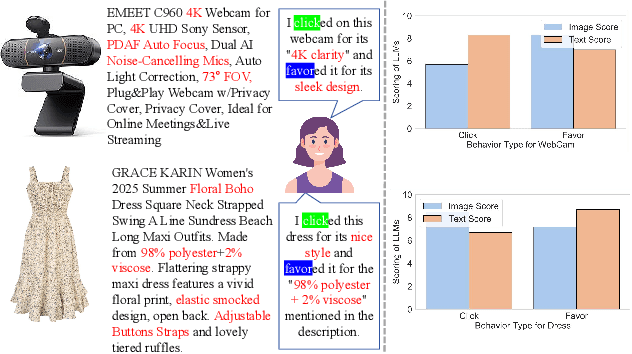

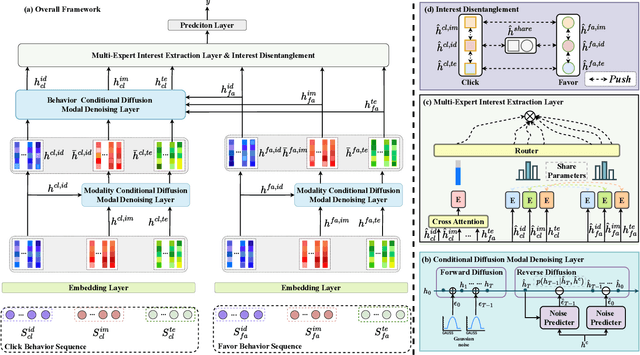
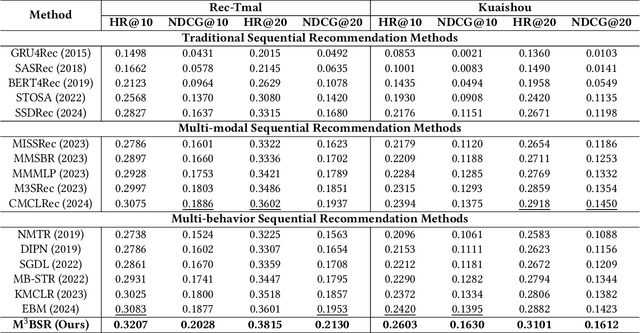
Abstract:The sequential recommendation system utilizes historical user interactions to predict preferences. Effectively integrating diverse user behavior patterns with rich multimodal information of items to enhance the accuracy of sequential recommendations is an emerging and challenging research direction. This paper focuses on the problem of multi-modal multi-behavior sequential recommendation, aiming to address the following challenges: (1) the lack of effective characterization of modal preferences across different behaviors, as user attention to different item modalities varies depending on the behavior; (2) the difficulty of effectively mitigating implicit noise in user behavior, such as unintended actions like accidental clicks; (3) the inability to handle modality noise in multi-modal representations, which further impacts the accurate modeling of user preferences. To tackle these issues, we propose a novel Multi-Modal Multi-Behavior Sequential Recommendation model (M$^3$BSR). This model first removes noise in multi-modal representations using a Conditional Diffusion Modality Denoising Layer. Subsequently, it utilizes deep behavioral information to guide the denoising of shallow behavioral data, thereby alleviating the impact of noise in implicit feedback through Conditional Diffusion Behavior Denoising. Finally, by introducing a Multi-Expert Interest Extraction Layer, M$^3$BSR explicitly models the common and specific interests across behaviors and modalities to enhance recommendation performance. Experimental results indicate that M$^3$BSR significantly outperforms existing state-of-the-art methods on benchmark datasets.
* SIGIR 2025
Unleashing the Potential of Consistency Learning for Detecting and Grounding Multi-Modal Media Manipulation
Jun 06, 2025Abstract:To tackle the threat of fake news, the task of detecting and grounding multi-modal media manipulation DGM4 has received increasing attention. However, most state-of-the-art methods fail to explore the fine-grained consistency within local content, usually resulting in an inadequate perception of detailed forgery and unreliable results. In this paper, we propose a novel approach named Contextual-Semantic Consistency Learning (CSCL) to enhance the fine-grained perception ability of forgery for DGM4. Two branches for image and text modalities are established, each of which contains two cascaded decoders, i.e., Contextual Consistency Decoder (CCD) and Semantic Consistency Decoder (SCD), to capture within-modality contextual consistency and across-modality semantic consistency, respectively. Both CCD and SCD adhere to the same criteria for capturing fine-grained forgery details. To be specific, each module first constructs consistency features by leveraging additional supervision from the heterogeneous information of each token pair. Then, the forgery-aware reasoning or aggregating is adopted to deeply seek forgery cues based on the consistency features. Extensive experiments on DGM4 datasets prove that CSCL achieves new state-of-the-art performance, especially for the results of grounding manipulated content. Codes and weights are avaliable at https://github.com/liyih/CSCL.
Improved Immiscible Diffusion: Accelerate Diffusion Training by Reducing Its Miscibility
May 24, 2025Abstract:The substantial training cost of diffusion models hinders their deployment. Immiscible Diffusion recently showed that reducing diffusion trajectory mixing in the noise space via linear assignment accelerates training by simplifying denoising. To extend immiscible diffusion beyond the inefficient linear assignment under high batch sizes and high dimensions, we refine this concept to a broader miscibility reduction at any layer and by any implementation. Specifically, we empirically demonstrate the bijective nature of the denoising process with respect to immiscible diffusion, ensuring its preservation of generative diversity. Moreover, we provide thorough analysis and show step-by-step how immiscibility eases denoising and improves efficiency. Extending beyond linear assignment, we propose a family of implementations including K-nearest neighbor (KNN) noise selection and image scaling to reduce miscibility, achieving up to >4x faster training across diverse models and tasks including unconditional/conditional generation, image editing, and robotics planning. Furthermore, our analysis of immiscibility offers a novel perspective on how optimal transport (OT) enhances diffusion training. By identifying trajectory miscibility as a fundamental bottleneck, we believe this work establishes a potentially new direction for future research into high-efficiency diffusion training. The code is available at https://github.com/yhli123/Immiscible-Diffusion.
Benchmarking Chest X-ray Diagnosis Models Across Multinational Datasets
May 21, 2025Abstract:Foundation models leveraging vision-language pretraining have shown promise in chest X-ray (CXR) interpretation, yet their real-world performance across diverse populations and diagnostic tasks remains insufficiently evaluated. This study benchmarks the diagnostic performance and generalizability of foundation models versus traditional convolutional neural networks (CNNs) on multinational CXR datasets. We evaluated eight CXR diagnostic models - five vision-language foundation models and three CNN-based architectures - across 37 standardized classification tasks using six public datasets from the USA, Spain, India, and Vietnam, and three private datasets from hospitals in China. Performance was assessed using AUROC, AUPRC, and other metrics across both shared and dataset-specific tasks. Foundation models outperformed CNNs in both accuracy and task coverage. MAVL, a model incorporating knowledge-enhanced prompts and structured supervision, achieved the highest performance on public (mean AUROC: 0.82; AUPRC: 0.32) and private (mean AUROC: 0.95; AUPRC: 0.89) datasets, ranking first in 14 of 37 public and 3 of 4 private tasks. All models showed reduced performance on pediatric cases, with average AUROC dropping from 0.88 +/- 0.18 in adults to 0.57 +/- 0.29 in children (p = 0.0202). These findings highlight the value of structured supervision and prompt design in radiologic AI and suggest future directions including geographic expansion and ensemble modeling for clinical deployment. Code for all evaluated models is available at https://drive.google.com/drive/folders/1B99yMQm7bB4h1sVMIBja0RfUu8gLktCE
CoreNet: Conflict Resolution Network for Point-Pixel Misalignment and Sub-Task Suppression of 3D LiDAR-Camera Object Detection
Jan 11, 2025



Abstract:Fusing multi-modality inputs from different sensors is an effective way to improve the performance of 3D object detection. However, current methods overlook two important conflicts: point-pixel misalignment and sub-task suppression. The former means a pixel feature from the opaque object is projected to multiple point features of the same ray in the world space, and the latter means the classification prediction and bounding box regression may cause mutual suppression. In this paper, we propose a novel method named Conflict Resolution Network (CoreNet) to address the aforementioned issues. Specifically, we first propose a dual-stream transformation module to tackle point-pixel misalignment. It consists of ray-based and point-based 2D-to-BEV transformations. Both of them achieve approximately unique mapping from the image space to the world space. Moreover, we introduce a task-specific predictor to tackle sub-task suppression. It uses the dual-branch structure which adopts class-specific query and Bbox-specific query to corresponding sub-tasks. Each task-specific query is constructed of task-specific feature and general feature, which allows the heads to adaptively select information of interest based on different sub-tasks. Experiments on the large-scale nuScenes dataset demonstrate the superiority of our proposed CoreNet, by achieving 75.6\% NDS and 73.3\% mAP on the nuScenes test set without test-time augmentation and model ensemble techniques. The ample ablation study also demonstrates the effectiveness of each component. The code is released on https://github.com/liyih/CoreNet.
RCTrans: Radar-Camera Transformer via Radar Densifier and Sequential Decoder for 3D Object Detection
Dec 17, 2024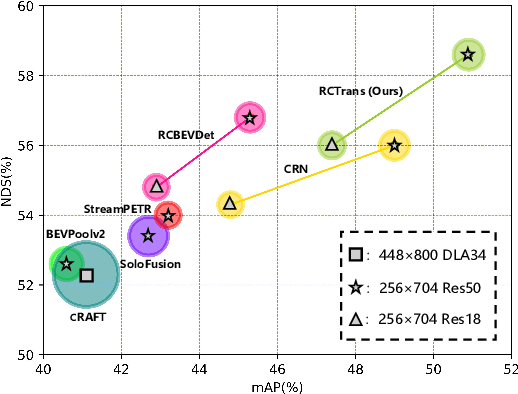
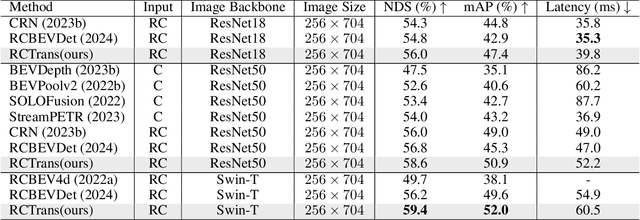
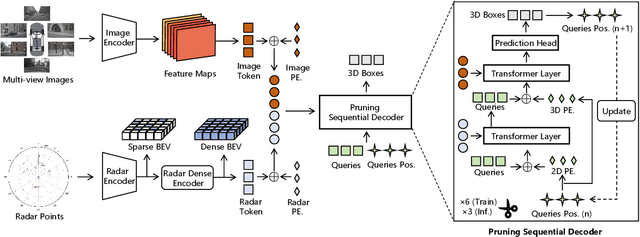
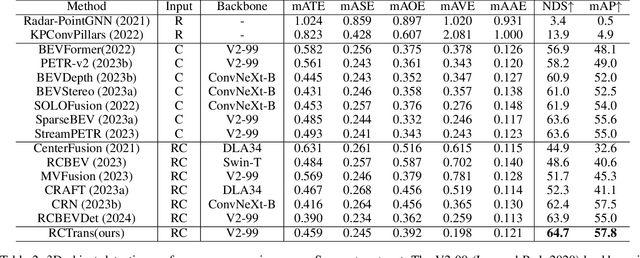
Abstract:In radar-camera 3D object detection, the radar point clouds are sparse and noisy, which causes difficulties in fusing camera and radar modalities. To solve this, we introduce a novel query-based detection method named Radar-Camera Transformer (RCTrans). Specifically, we first design a Radar Dense Encoder to enrich the sparse valid radar tokens, and then concatenate them with the image tokens. By doing this, we can fully explore the 3D information of each interest region and reduce the interference of empty tokens during the fusing stage. We then design a Pruning Sequential Decoder to predict 3D boxes based on the obtained tokens and random initialized queries. To alleviate the effect of elevation ambiguity in radar point clouds, we gradually locate the position of the object via a sequential fusion structure. It helps to get more precise and flexible correspondences between tokens and queries. A pruning training strategy is adopted in the decoder, which can save much time during inference and inhibit queries from losing their distinctiveness. Extensive experiments on the large-scale nuScenes dataset prove the superiority of our method, and we also achieve new state-of-the-art radar-camera 3D detection results. Our implementation is available at https://github.com/liyih/RCTrans.
UniPose: A Unified Multimodal Framework for Human Pose Comprehension, Generation and Editing
Nov 25, 2024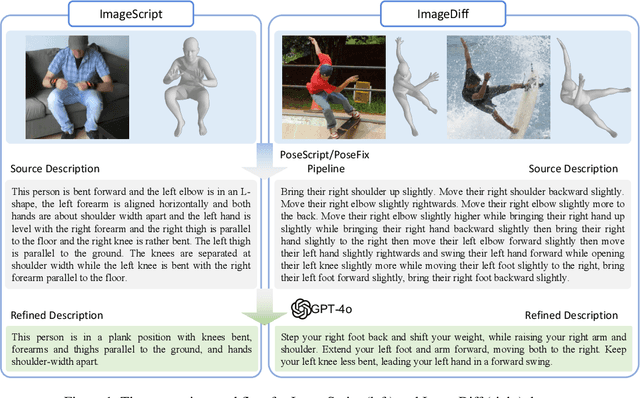
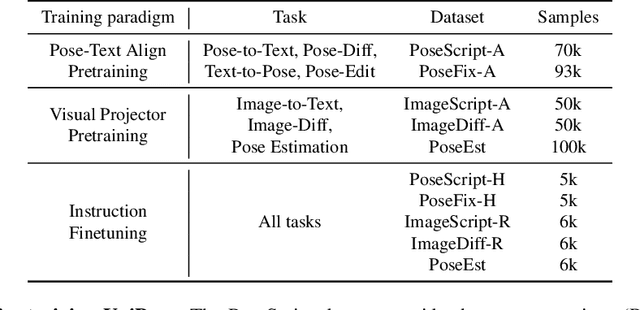
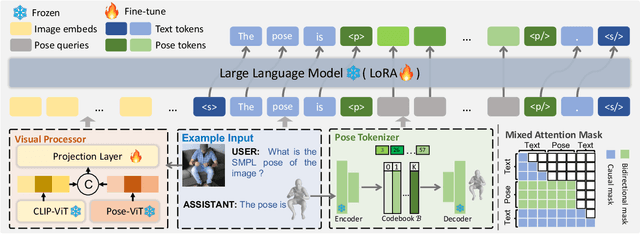
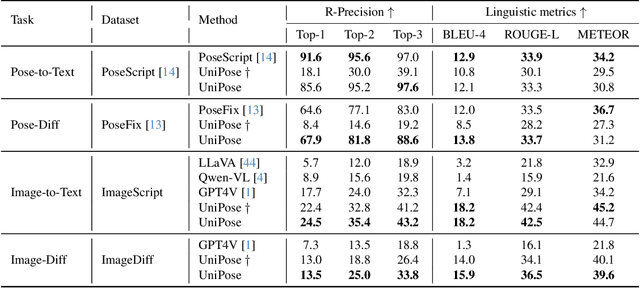
Abstract:Human pose plays a crucial role in the digital age. While recent works have achieved impressive progress in understanding and generating human poses, they often support only a single modality of control signals and operate in isolation, limiting their application in real-world scenarios. This paper presents UniPose, a framework employing Large Language Models (LLMs) to comprehend, generate, and edit human poses across various modalities, including images, text, and 3D SMPL poses. Specifically, we apply a pose tokenizer to convert 3D poses into discrete pose tokens, enabling seamless integration into the LLM within a unified vocabulary. To further enhance the fine-grained pose perception capabilities, we facilitate UniPose with a mixture of visual encoders, among them a pose-specific visual encoder. Benefiting from a unified learning strategy, UniPose effectively transfers knowledge across different pose-relevant tasks, adapts to unseen tasks, and exhibits extended capabilities. This work serves as the first attempt at building a general-purpose framework for pose comprehension, generation, and editing. Extensive experiments highlight UniPose's competitive and even superior performance across various pose-relevant tasks.
Mitigating Object Hallucination via Concentric Causal Attention
Oct 21, 2024Abstract:Recent Large Vision Language Models (LVLMs) present remarkable zero-shot conversational and reasoning capabilities given multimodal queries. Nevertheless, they suffer from object hallucination, a phenomenon where LVLMs are prone to generate textual responses not factually aligned with image inputs. Our pilot study reveals that object hallucination is closely tied with Rotary Position Encoding (RoPE), a widely adopted positional dependency modeling design in existing LVLMs. Due to the long-term decay in RoPE, LVLMs tend to hallucinate more when relevant visual cues are distant from instruction tokens in the multimodal input sequence. Additionally, we observe a similar effect when reversing the sequential order of visual tokens during multimodal alignment. Our tests indicate that long-term decay in RoPE poses challenges to LVLMs while capturing visual-instruction interactions across long distances. We propose Concentric Causal Attention (CCA), a simple yet effective positional alignment strategy that mitigates the impact of RoPE long-term decay in LVLMs by naturally reducing relative distance between visual and instruction tokens. With CCA, visual tokens can better interact with instruction tokens, thereby enhancing model's perception capability and alleviating object hallucination. Without bells and whistles, our positional alignment method surpasses existing hallucination mitigation strategies by large margins on multiple object hallucination benchmarks.
QuadBEV: An Efficient Quadruple-Task Perception Framework via Bird's-Eye-View Representation
Oct 09, 2024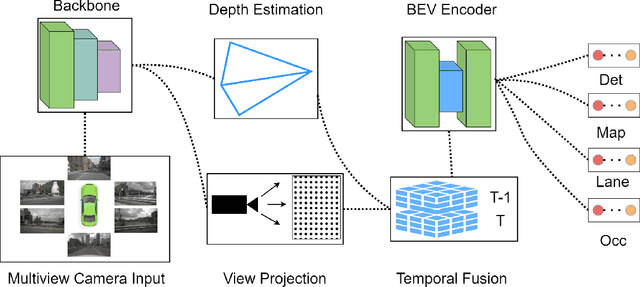
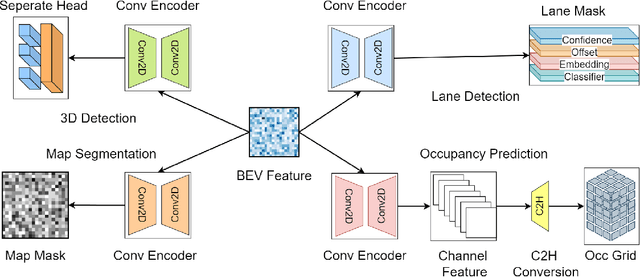
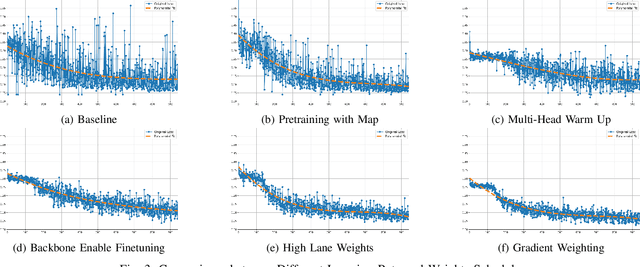

Abstract:Bird's-Eye-View (BEV) perception has become a vital component of autonomous driving systems due to its ability to integrate multiple sensor inputs into a unified representation, enhancing performance in various downstream tasks. However, the computational demands of BEV models pose challenges for real-world deployment in vehicles with limited resources. To address these limitations, we propose QuadBEV, an efficient multitask perception framework that leverages the shared spatial and contextual information across four key tasks: 3D object detection, lane detection, map segmentation, and occupancy prediction. QuadBEV not only streamlines the integration of these tasks using a shared backbone and task-specific heads but also addresses common multitask learning challenges such as learning rate sensitivity and conflicting task objectives. Our framework reduces redundant computations, thereby enhancing system efficiency, making it particularly suited for embedded systems. We present comprehensive experiments that validate the effectiveness and robustness of QuadBEV, demonstrating its suitability for real-world applications.
Learning Content-Aware Multi-Modal Joint Input Pruning via Bird's-Eye-View Representation
Oct 09, 2024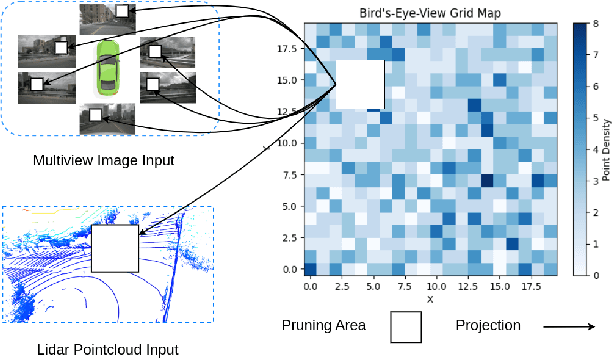
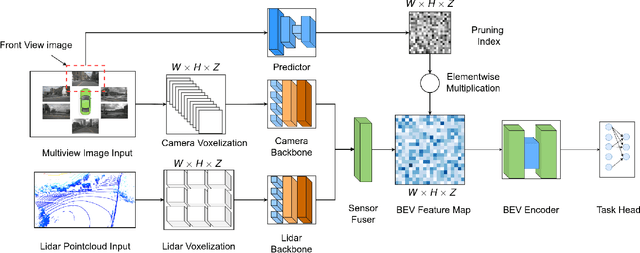
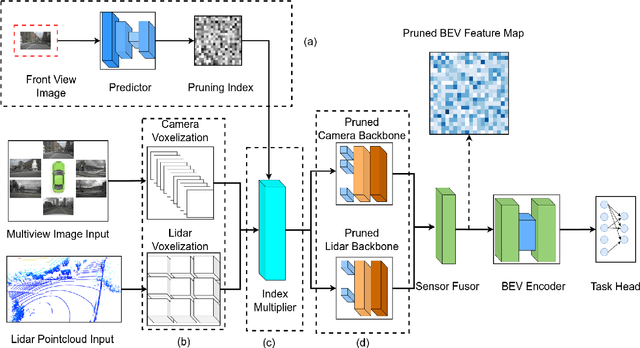
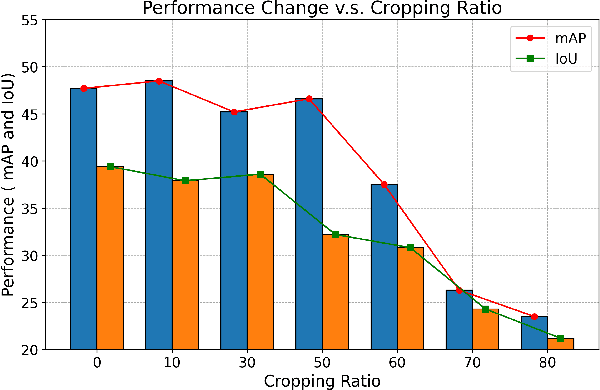
Abstract:In the landscape of autonomous driving, Bird's-Eye-View (BEV) representation has recently garnered substantial academic attention, serving as a transformative framework for the fusion of multi-modal sensor inputs. This BEV paradigm effectively shifts the sensor fusion challenge from a rule-based methodology to a data-centric approach, thereby facilitating more nuanced feature extraction from an array of heterogeneous sensors. Notwithstanding its evident merits, the computational overhead associated with BEV-based techniques often mandates high-capacity hardware infrastructures, thus posing challenges for practical, real-world implementations. To mitigate this limitation, we introduce a novel content-aware multi-modal joint input pruning technique. Our method leverages BEV as a shared anchor to algorithmically identify and eliminate non-essential sensor regions prior to their introduction into the perception model's backbone. We validatethe efficacy of our approach through extensive experiments on the NuScenes dataset, demonstrating substantial computational efficiency without sacrificing perception accuracy. To the best of our knowledge, this work represents the first attempt to alleviate the computational burden from the input pruning point.
 Add to Chrome
Add to Chrome Add to Firefox
Add to Firefox Add to Edge
Add to Edge